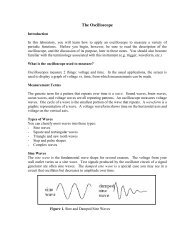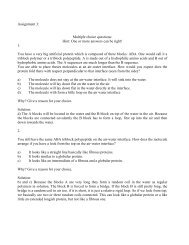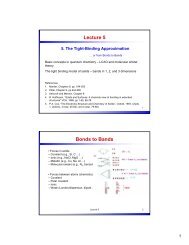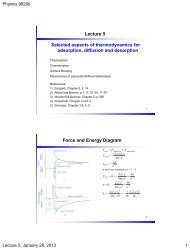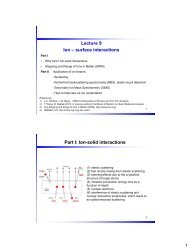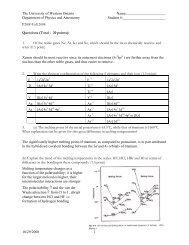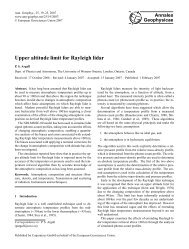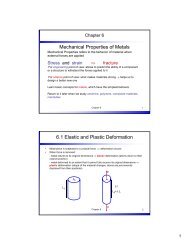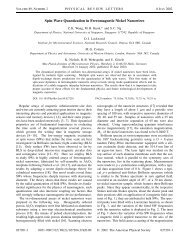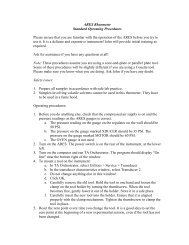You also want an ePaper? Increase the reach of your titles
YUMPU automatically turns print PDFs into web optimized ePapers that Google loves.
Biological Adhesion for Locomotion on Rough Surfaceselastohydrodynamics, 21 but it is clear thatthe open structure of the toe-pad fiberarray system will facilitate this by enablingwater to flow laterally in the space betweenthe fibers. This flow channel becomes veryimportant for very thin water films,because for flat surfaces the time t it takesto squeeze the liquid film down to thethickness d diverges as t ~ d −2 . Completesqueeze-out of the liquid between thethin plates and the solid wall is unlikelyto occur, as most stone walls consist ofpolar oxides that are hydrophilic, makinga dewetting transition unlikely to occur. 22–24However, if the liquid layer thicknessis ~1 nm or less, and if the van der Waalsinteraction between the solid walls isattractive 25 (which is likely to be the casefor a fiber array system involving akeratin–water–stone interface), then theinteraction may be strong enough to enablethe gecko to move on a stone wall undervery wet conditions.It was demonstrated recently that thepulloff force for a single fiber plate from aflat glass surface submerged in water isabout six times smaller than under dryconditions. 26 That is, the high permittivityof water reduces the van der Waals interactionbetween the solids, 25 and furthermore,a few monolayers of water mayseparate the solids in the contact region,giving rise to the small observed adhesiveinteraction. It is clear that the <strong>adhesion</strong>force of a whole gecko foot is reduced substantially,and this seems to be in agreementwith observations of geckos whenrunning on wet surfaces.Typical pressure-sensitive adhesiveswill not adhere on wet substrates. Becausethe surface of an adhesive tape is compactand locally flat, it will take a very longtime to reduce the water film thickness tothe nanometer range where the van derWaals interaction may give rise to bindingbetween the walls.substrate surface (e.g., a stone wall)than to the toe pad so that after pressinga contaminated toe pad against a cleansurface, the particles are removed fromthe toe pad. This does not seem a plausibleexplanation, because a similar argumentwould lead to the conclusion thatadhesive tape contaminated by similarparticles should bind strongly to solidsurfaces via the particles, which is notthe case. In fact, if Scotch ® tape is pressedjust a couple of times against a dirty surface,it will permanently lose its adhe -sive properties. Thus, one may ask how agecko is able to keep its toe pads cleanenough to be able to move on dirty solidwalls.I believe that the remarkable selfcleaningproperties of gecko adhesivepads are explained by minute lateralmovements of the toe pads relative to thesubstrate that scratch away the particles.To bind strongly to a substrate, the geckomust shear the toe pad in a special directionto line up (or bend) the binding platesinto a position that gives strong bondingto the substrate. I suggest that motion inthe opposite direction, while the toe pad issqueezed against the (rough) substrate,will scratch away solid particles trappedon the toe pad surface (see Figure 6).Deterioration of Adhesive Systemand Fiber Wear<strong>Gecko</strong>s have a highly optimized adhesivesystem for locomotion. Because <strong>adhesion</strong>tends to increase when the fibers andplates are thinner, it is likely that the thicknessof gecko fibers and plates are closeto the limit of what is mechanically possiblein terms of stability and strength, 29which is consistent with experimentalobservations. Thus, broken fibers adheringto glass have been observed aftershearing the toe pad along the surface. 30Because the gecko usually does not needto adhere to very smooth surfaces, such asa glass surface, the plate–substrate bindingwill in most cases be much weakerthan for the glass surface, and the toepad wear (per unit distance moved) correspondinglymuch smaller. Nevertheless,in geckos in their natural environment, thetoe–pad substrate <strong>adhesion</strong> is at a maximumafter molt and rapidly decreasesthereafter; 27,30 and this is most likelybecause of fiber wear.Attachment and DetachmentExperiments have shown that a 25 ggecko may bind so strongly to a flat substratethat a force of the order of 10 N ormore may be necessary to detach thegecko from the substrate. The binding torough substrates may be much weakerbut still strong enough for the gecko tomove rapidly on the surface withoutfalling. This brings up two questions: Whydoes the gecko keep its legs and armspointing away from its body with smallangle θ to the substrate? How is it possiblefor the gecko to rapidly break the toe–padsubstrate bond during rapid motion onthe substrate? Both problems are relatedto interfacial crack propagation (or peeling),and can be understood by a simpleanalogy with peeling adhesive tape.Consider a thin elastic film bonded to aflat substrate, as indicated in Figures 7aand 7b. If we can neglect the elastic energystored in the film, the normal componentof the pulloff force is given by 2,12F ⊥= Fsinθ = ∆γBsinθ/(1 − cosθ), (1)where θ is the peel angle and B the width ofthe film. For a small peel angle, this givesF ⊥≈ 2∆γB/θ, (2)so that the perpendicular pull-off force F ⊥diverges as the peel angle θ approaches 0.Self-Cleaning Biological AdhesiveSystems<strong>Gecko</strong>s can move on contaminated surfaces,for example, a dirty vertical stonewall. Because the gecko toe pad is able tobind strongly to solid surfaces, one wouldexpect that small solid particles—stonefragments, dust, pollen—would bind tothe pad surface and quickly “passivate” it.However, this does not seem to occur, andthe geckos never clean their toe pads bygrooming, in contrast to flies, beetles, andother insects. In fact, a gecko’s toe padretains its stickiness for up to six months 27(the time period between molts) seeminglywithout being actively cleaned. Itwas recently suggested 28 that small solidparticles may bind more strongly to theSubstrateParticleFigure 6. Removal of a dirt particle from foot fibers via lateral shear (scratch motion).MRS BULLETIN • VOLUME 32 • JUNE 2007 • www/mrs.org/bulletin 489
Biological Adhesion for Locomotion on Rough SurfacesaFbcθθ<strong>Gecko</strong> arm<strong>Gecko</strong>toeThis is why a very large pulloff force is necessaryto remove a rigid block taped to aflat substrate; this case corresponds to θ = 0.The gecko adheres by applying muscleforce that keeps the angle θ between its legsand the substrate very small. This will maximizethe pulloff force, which may beimportant on very rough and contaminatedsurfaces.The peeling angle θ should be large toquickly break the toe pad–substrate bondduring fast motion on the substrate. Inparticular, note that F ⊥→ 0 as θ→π.Although this limiting case cannot be realizedby the gecko, a large peel angleresults from the novel way in which thegecko breaks the toe pad–substrate contactby rolling or peeling the toe, from thetip, 31 off the substrate (see Figure 7c). It isalso possible that at any given time, thegecko only attaches the fraction of toe padfibers necessary to obtain sufficient <strong>adhesion</strong>to the substrate.FRollingFigure 7. Peeling adhesive tape from aflat substrate. (a) If the peel angle θ issmall, the pulloff force is very large,while the opposite is true when the peelangle is large (b). (c) The gecko removesthe contact to the substrate by rolling itstoes upward from the substrate. 31Summary and ConclusionAll natural surfaces have roughness onmany different length scales. Naturalselection has optimized the adhesive padsof many animals for attachment anddetachment to natural surfaces. The constructionof these adhesive pads is mainlythe result of two principles:1. Maximum <strong>adhesion</strong> requires usingnoncompact solids built from thin fibersand plates (or walls).2. The fibers and plates (or walls) cannotbe too thin, as this would result in collapseor bundling of the structures.It is clear that a detailed description ofthe function of biological adhesive systemsused for locomotion needs to include notonly the finer points of the mechanics ofcontact (attachment and detachment) onsmooth and rough surfaces, but also interfacialinteractions and the active biolog -ical functions performed by the animal.Although very complex and irreproduciblesynthetically, such an integratedsystem may inspire new ideas leading toimproved reversible synthetic adhesivesystems based on similar principles. Suchsystems will have great advantages overadhesives used today, and may make possiblenew applications; for an example, seethe article by Daltorio et al. in this issuethat discusses wall-climbing robots.AcknowledgmentsI thank K. Autumn, W. Federle, andS. Gorb for useful discussions.References1. B.N.J. Persson et al., J. Phys.: Condens. Matter17, R1 (2005).2. K. Kendall, Molecular Adhesion and ItsApplications (Kluwer, New York, 2001).3. K.N.G. Fuller, D. Tabor, Proc. R. Soc. London,Ser. A 345, 327 (1975).4. B.N.J. Persson, Eur. Phys. J. E8, 385 (2002).5. B.N.J. Persson, Surf. Sci. Rep. 61, 201 (2006).6. V.N. Samoilov, I.M. Sivebaek, B.N.J. Persson,J. Chem. Phys. 121, 9639 (2004).7. K.R. Shull, C. Creton, J. Polym. Sci. B42, 4023(2004).8. B.N.J. Persson, O. Albohr, C. Creton,V. Peveri, J. Chem. Phys. 120, 8779 (2004).9. S. Gorb, Attachment Devices of Insect Cuticle(Kluwer, Dordrecht, 2001); M. Scherge, S. Gorb,Biological Micro- and Nanotribology: Nature’sSolutions (Springer, Berlin, 2001).10. B.N.J. Persson, J. Chem. Phys. 118, 7614(2003).11. Y. Jiao, S.N. Gorb, M. Scherge, J. Exp. Biol.203, 1887 (2000).12. B.N.J. Persson, S. Gorb, J. Chem. Phys. 119,11437 (2004).13. C. Carbone, B.N.J. Persson, Phys. Rev. B 70,125407 (2004).14. N.J. Glassmaker, A. Jagota, C.-Y. Hui,J. Kim, J. R. Soc. Interface 1, 23 (2004).15. A. Jagota, S.J. Bennison, Integr. Comp. Biol.,42, 1140 (2002)16. F. Haas, S. Gorb, Arthropod Struct. Dev. 33,45 (2004).17. W. Federle, J. Exp. Biol. 209, 2611 (2006).18. K. Autumn et al., Proc. Natl. Acad. Sci. USA99, 12252 (2002).19. E. Arzt, S. Gorb, R. Spolenak, Proc. Natl.Acad. Sci. USA 100, 10603 (2003).20. H. Gao, Mech. Mater. 37, 275 (2005). In thisreference, the optimal shape of an elastic solidfor maximal pulloff force from a perfectlysmooth substrate is discussed. However, geckosneed to adhere to randomly rough surfaces andin this case there exists no unique optimal shape.21. B.N.J. Persson, Sliding Friction: PhysicalPrinciples and Applications (Springer, Heidelberg,2nd ed., 2000).22. B.N.J. Persson, F. Mugele, J. Phys.: Condens.Matter 16, R295 (2004).23. F. Brochard-Wyart, P.G. de Gennes, J. Phys.:Condens. Matter 6, A9 (1994); P. Martin,F. Brochard-Wyart, Phys. Rev. Lett. 80, 3296(1998); P. Martin, A. Buguin, F. Brochard-Wyart,Langmuir 17, 6553 (2001).24. B.N.J. Persson, A. Volokitin, E. Tosatti, Eur.Phys. J. E11, 409 (2003); C. Carbone, B.N.J.Persson, J. Chem. Phys. 121, 2246 (2004).25. J. Israelachvili, Intermolecular and SurfaceForces (Academic Press, London, 1992).26. G. Huber et al., Proc. Natl. Acad. Sci. USA102, 16293 (2005).27. U. Hiller, R. Blaschke, Naturwissenschaften54, 344 (1997).28. W.R. Hansen, K. Autumn, Proc. Natl. Acad.Sci. USA 102, 385 (2005). The argument presentedin this reference for self-cleaning maywork for perfectly smooth substrates and particles,but real surfaces have roughness on manydifferent length scales, and in this case the bindingof a hard particle to a hard substrate will benegligible.29. R. Spolenak, S. Gorb, E. Arzt, Acta Biomater.1, 5 (2005).30. S. Gorb, private communication.31. Y. Tian et al., Proc. Natl. Acad. Sci. USA 103,19320 (2006). ■490 MRS BULLETIN • VOLUME 32 • JUNE 2007 • www/mrs.org/bulletin



